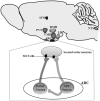Neuroanatomical determinants of the sympathetic nerve responses evoked by leptin
- PMID: 22714900
- PMCID: PMC3496820
- DOI: 10.1007/s10286-012-0168-4
Neuroanatomical determinants of the sympathetic nerve responses evoked by leptin
Abstract
Leptin is an adipocyte-derived hormone that relays a satiety signal to the brain. The effect of leptin on the sympathetic nervous system is an important aspect in the regulation of energy homeostasis as well as several other physiological functions. The arcuate nucleus of the hypothalamus is considered a major site for the regulation of physiological processes by leptin. However, there is growing recognition that other hypothalamic and extra-hypothalamic brain nuclei are important for leptin regulation of physiological processes including sympathetic nerve traffic. The current review discusses the various hypothalamic and extra-hypothalamic nuclei that have been implicated in leptin-induced increase in regional sympathetic nerve activity. The continuous rise in the prevalence of obesity underscores the importance of understanding the underlying neural mechanisms regulating sympathetic traffic to different tissues to design effective strategies to reverse obesity and associated diseases.
Conflict of interest statement
Figures


Similar articles
-
Leptin and the central neural mechanisms of obesity hypertension.Drugs Today (Barc). 2002 Dec;38(12):807-17. doi: 10.1358/dot.2002.38.12.740203. Drugs Today (Barc). 2002. PMID: 12582470 Review.
-
Hypothalamic arcuate nucleus mediates the sympathetic and arterial pressure responses to leptin.Hypertension. 2007 Mar;49(3):647-52. doi: 10.1161/01.HYP.0000254827.59792.b2. Epub 2006 Dec 26. Hypertension. 2007. PMID: 17190874
-
Role of leptin in energy expenditure: the hypothalamic perspective.Am J Physiol Regul Integr Comp Physiol. 2017 Jun 1;312(6):R938-R947. doi: 10.1152/ajpregu.00045.2016. Epub 2017 Mar 29. Am J Physiol Regul Integr Comp Physiol. 2017. PMID: 28356295 Review.
-
Hypothalamic ERK mediates the anorectic and thermogenic sympathetic effects of leptin.Diabetes. 2009 Mar;58(3):536-42. doi: 10.2337/db08-0822. Epub 2008 Dec 9. Diabetes. 2009. PMID: 19066310 Free PMC article.
-
A brain leptin-renin angiotensin system interaction in the regulation of sympathetic nerve activity.Am J Physiol Heart Circ Physiol. 2012 Jul 15;303(2):H197-206. doi: 10.1152/ajpheart.00974.2011. Epub 2012 May 18. Am J Physiol Heart Circ Physiol. 2012. PMID: 22610169 Free PMC article.
Cited by
-
Resistance to the sympathoexcitatory effects of insulin and leptin in late pregnant rats.J Physiol. 2019 Aug;597(15):4087-4100. doi: 10.1113/JP278282. Epub 2019 Jul 11. J Physiol. 2019. PMID: 31209877 Free PMC article.
-
Neural Control of Non-vasomotor Organs in Hypertension.Curr Hypertens Rep. 2016 Apr;18(4):30. doi: 10.1007/s11906-016-0635-8. Curr Hypertens Rep. 2016. PMID: 26957306 Free PMC article. Review.
-
Controls of Central and Peripheral Blood Pressure and Hemorrhagic/Hypovolemic Shock.J Clin Med. 2023 Jan 31;12(3):1108. doi: 10.3390/jcm12031108. J Clin Med. 2023. PMID: 36769755 Free PMC article. Review.
-
Role of the Paraventricular Nucleus of the Hypothalamus in the Sympathoexcitatory Effects of Leptin.Hypertension. 2015 Nov;66(5):1034-41. doi: 10.1161/HYPERTENSIONAHA.115.06017. Epub 2015 Sep 14. Hypertension. 2015. PMID: 26370892 Free PMC article.
-
Pathophysiology and Potential Non-Pharmacologic Treatments of Obesity or Kidney Disease Associated Refractory Hypertension.Curr Hypertens Rep. 2017 Feb;19(2):18. doi: 10.1007/s11906-017-0713-6. Curr Hypertens Rep. 2017. PMID: 28243928 Review.
References
-
- Morton GJ, Cummings DE, Baskin DG, Barsh GS, Schwartz MW. Central nervous system control of food intake and body weight. Nature. 2006;443(7109):289–295. - PubMed
-
- Elmquist JK, Elias CF, Saper CB. From lesions to leptin: hypothalamic control of food intake and body weight. Neuron. 1999;22(2):221–232. - PubMed
-
- Zhang Y, Proenca R, Maffei M, Barone M, Leopold L, Friedman JM. Positional cloning of the mouse obese gene and its human homologue. Nature. 1994;372(6505):425–432. - PubMed
-
- Minokoshi Y, Kim YB, Peroni OD, Fryer LG, Muller C, Carling D, Kahn BB. Leptin stimulates fatty-acid oxidation by activating AMP-activated protein kinase. Nature. 2002;415(6869):339–343. - PubMed
-
- Nogueiras R, Wiedmer P, Perez-Tilve D, Veyrat-Durebex C, Keogh JM, Sutton GM, Pfluger PT, Castaneda TR, Neschen S, Hofmann SM, Howles PN, Morgan DA, Benoit SC, Szanto I, Schrott B, Schurmann A, Joost HG, Hammond C, Hui DY, Woods SC, Rahmouni K, Butler AA, Farooqi IS, O'Rahilly S, Rohner-Jeanrenaud F, Tschop MH. The central melanocortin system directly controls peripheral lipid metabolism. J Clin Invest. 2007;117(11):3475–3488. - PMC - PubMed
Publication types
MeSH terms
Substances
Grants and funding
LinkOut - more resources
Full Text Sources

